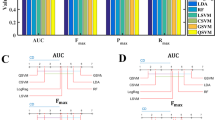Abstract
We propose a method of diagnosing prostate cancer using magnetic resonance imaging data. Logistic regression and nearest neighbor classification are combined to identify the risk of cancer. Our method performs well, having 79 % predictive accuracy, and an area under the ROC curve of 0.85. It identifies the most aggressive cancers with 82 % accuracy.





Similar content being viewed by others
References
Akdas A, Tarcan T, Turkeri L, Cevik I, Biren T, Gurmen N (1995) The diagnostic accuracy of digital rectal examination, transrectal ultrasonography, prostate-specific antigen (PSA) and PSA density in prostate carcinoma. Br J Urol 76(s1):54–56
Akhter W, Chinegwundoh F (2013) Role of MRI in the diagnosis of prostate cancer. Clin Exp Med Sci 1(3):111–116
Amsellem-Ouazana D, Younes P, Conquy S, Peyromaure M, Flam T, Debré B, Zerbib M (2005) Negative prostatic biopsies in patients with a high risk of prostate cancer. Is the combination of endorectal MRI and magnetic resonance spectroscopy imaging (MRSI) a useful tool? A preliminary study. Eur Urol 47(5):582–586
Catalona WJ, Richie JP, Ahmann FR, Hudson MA, Scardino PT, Flanigan RC, de Kernion JB, Ratliff TL, Kavoussi LR, Dalkin BL (1994) Comparison of digital rectal examination and serum prostate specific antigen in the early detection of prostate cancer: results of a multicenter clinical trial of 6,630 men. J Urol 151(5):1283–1290
Cooper CP, Merritt TL, Ross LP, John LV, Jorgensen CM (2004) To screen or not to screen, when clinical guidelines disagree: primary care physicians’ use of the PSA test. Prev Med 38(2):182–191
Fawcett Tom (1977) An introduction to ROC analysis. Pattern Recognit Lett 27(8):861–874
Gleason DF, Mellinger GT (1974) Prediction of prognosis for prostatatic adenocarcinoma by combined histological grading and clinical staging. J Urol 111:58–64
Hegde J, Mulkern R, Panych L, Fennessy F, Fedorov A, Maier S, Tempany C (2013) Multiparametric MRI of prostate cancer: an update on state-of-the-art techniques and their performance in detecting and localizing prostate cancer. J Magn Reson Imaging 37(5):1035–1054
Hoeks C, Schouten M, Bomers J, Hoogendoorn S, Hulsbergen-van de Kaa C, Hambrock T, Vergunst H, Sedelaar J, Futterer J, Barentsz J (2012) Three-Tesla magnetic resonance–guided prostate biopsy in men with increased prostate-specific antigen and repeated, negative, random, systematic, transrectal ultrasound biopsies: detection of clinically significant prostate cancers. Eur Urol 62(5):902–909
Hoffman RM, Gilliland FD, Adams-Cameron M, Hunt WC, Key CR (2002) Prostate-specific antigen testing accuracy in community practice. BMC Fam Pract 3(1):19
Howlader N, Noone AM, Krapcho M, Neyman N, Aminou R, Altekruse SF, Kosary CL, Ruhl J, Tatalovich Z, Cho H, Mariotto A, Eisner MP, Lewis DR, Chen HS, Feuer EJ, Cronin KA (2012) SEER cancer statistics review, 1975–2009 (Vintage 2009 Populations). National Cancer Institute, Bethesda, MD
Kirkham APS, Emberton M, Allen C (2006) How good is MRI at detecting and characterising cancer within the prostate? Eur Urol 50(6):1163–1174
Komai Y, Numao N, Yoshida S, Matsuoka Y, Nakanishi Y, Ishii C, Koga F, Saito K, Masuda H, Fujii Y, Kawakami S, Kihara K (2013) High diagnostic ability of multiparametric magnetic resonance imaging to detect anterior prostate cancer missed by transrectal 12-core biopsy. J Urol 190(3):867–873
Kurhanewicz J, Swanson MG, Nelson SJ, Vigneron DB (2002) Combined magnetic resonance imaging and spectroscopic imaging approach to molecular imaging of prostate cancer. J Magn Reson Imaging 16(4):451–463
Langer D, van der Kwast T, Evans A, Trachtenberg J, Wilson B, Haider M (2009) Prostate cancer detection with multi-parametric MRI: logistic regression analysis of quantitative T2, diffusion-weighted imaging, and dynamic contrast-enhanced MRI. J Magn Reson Imaging 30(2):327–334
Maan B, van der Heiden F, Futterer J (2012) A new prostate segmentation approach using multispectral magnetic resonance imaging and a statistical pattern classifier. SPIE Proceedings
Padhani AR, Gapinski CJ, Macvicar DA, Parker GJ, Suckling J, Revell PB, Leach MO, Dearnaley DP, Husband JE (2000) Dynamic contrast enhanced MRI of prostate cancer: correlation with morphology and tumour stage, histological grade and PSA. Clin Radiol 55(2):99–109
Salomon L, Colombel M, Patard JJ, Lefrere-Belda MA, Bellot J, Chopin D, Abbou CC (1999) Value of ultrasound-guided systematic sextant biopsies in prostate tumor mapping. Eur Urol 35(4):289–293
Siegel R, Naishadham D, Jemal A (2013) Cancer statistics. CA: A Cancer J Clin 63(1):11–30
Smith DS, Catalona WJ (1995) Interexaminer variability of digital rectal examination in detecting prostate cancer. Urology 45(1):70–74
Thompson I, Ankerst D, Chi C, Lucia S, Goodman P, Crowley J, Parnes H, Coltman C (2005) Operating characteristics of prostate-specific antigen in men with initial PSA level of 3.0 g/mL or lower. JAMA 294(1):66–70
Welch HG, Albertsen PC (2009) Prostate cancer diagnosis and treatment after the introduction of prostate-specific antigen screening: 1986–2005. J Natl Cancer Inst 101(19):1325–1329
Acknowledgments
We would like to thank Dr. Rao Gullapalli’s lab for providing the MRI dataset for this research. The second and third co-authors (BG & EW) dedicate this paper to the memory of Dr. Saul I. Gass (1926–2013). Saul was a colleague, mentor, and friend, and a victim of prostate cancer.
Author information
Authors and Affiliations
Corresponding author
Rights and permissions
About this article
Cite this article
Anderson, D., Golden, B., Wasil, E. et al. Predicting prostate cancer risk using magnetic resonance imaging data. Inf Syst E-Bus Manage 13, 599–608 (2015). https://doi.org/10.1007/s10257-014-0239-2
Received:
Revised:
Accepted:
Published:
Issue Date:
DOI: https://doi.org/10.1007/s10257-014-0239-2




